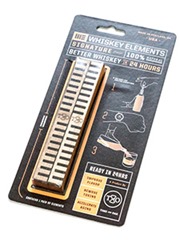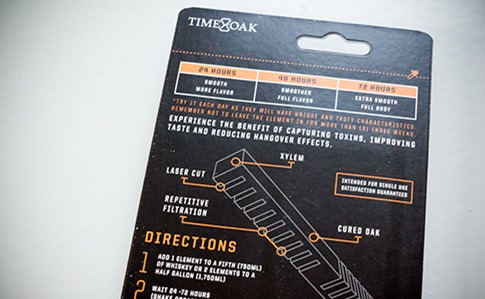
It’s said to make the whisky smoother in just 24 hours, with maximum results after 72 hours. The toasted wood will also add more vanilla and maple notes (or other flavours like smoke or winey notes, they have three types of elements at the moment), so essentially it mimics the effects of barrel ageing in a much shorter period. Last but not least, it’s supposed to capture toxins and reduce hangover effects.
I don’t believe the hangover stuff, but I was definitely interested in trying the maturation effect. I selected two whiskies for this experiment: anCnoc 12 Year Old, one of my favourites when it comes to fairly young, light but quality whisky, and Grant’s Family Reserve, a basic but decent blended whisky. I poured part of the original whiskies into sealed sample bottles and added one whisky element to the remaining liquid in the bottle.
Before we move to the results of this experiment, I can think of two downsides already:
- Once it’s inside, you can’t take it out unless you decant the bottle and pour everything in again. Wouldn’t it be handy if there were a thin synthetic thread attached to it? It probably fits in between the cork and the glass. Wait a minute… after 72 hours one of the elements seems to have swollen a little and I can’t get it out of the neck anymore. So you need to have a spare bottle available.
- Each element is 13 cm. long, which means you need (almost) an entire bottle to make it fully effective. It also means you’re wasting a whole bottle if you don’t like the result. Fine for a € 15-40 whisky, I guess, but I wouldn’t take the risk with an expensive single malt. Maybe half the size would be more practical?
Effect of the Whiskey Elements
First of all, it adds colour. Quickly. In the picture below, the first glass is the original anCnoc 12. The middle glass is the situation after 24 hours (noticeably darker) and the right glass is after 72 hours (virtually the same). So it boosts the colour quite rapidly and then slows down.
After 24 hours, the whisky had some added notes of pencil shavings, replacing the most delicate aromas of anCnoc 12: the bright fruity / floral top notes are gone. After 72 hours, it still has this new pencil aroma and it shows vanilla marshmallows and a little banana candy. I feel some of the identity of this whisky was replaced by aromas that I don’t necessarily associate with better whisky. I’m not convinced.
On the palate, I have to say it did smoothen a little after 24 hours. The original nervousness and beer-like youth have faded and the whisky became rounder, more caramelly if you like. This also makes it flatter though, erasing some depth. After 72 hours the harsher spicy / woody flavours start to get the upperhand, pushing away the original character and moving towards a virgin oak matured (or virgin oak finished) whisky.
For the Grant’s Family Reserve, after the right amount of time, it works out better. Oaky notes are not something you’d expect in a blended whisky and it makes it look more mature, on both the nose and the palate. Also the plankish / pencil side isn’t as noticeable as it is in the anCnoc. On the other hand there’s usually no shortage of vanilla and caramel flavours in a blend and you’ll have to take even more of these alongside the sophisticated oak influence. In the end though, you’re adding a € 7 element to a € 14 bottle, does that really make sense? They can only be used once by the way.
For a single malt, the effect of the Whiskey Elements seems difficult to predict. It had a pretty fine result on the taste but less so on the nose. It turned out 72 hours was too much for my taste, imparting an overdose of rough woody flavours, but once you know that, it’s too late of course. Personally I wouldn’t take the risk on other single malts. For blends, the effects were a bit more pleasant, but the price seems hard to justify.
For me it feels like trying to improve a painting you’ve bought. You wouldn’t dare modifying a real work of art, but it doesn’t make sense to waste paint on a reproduction either.

